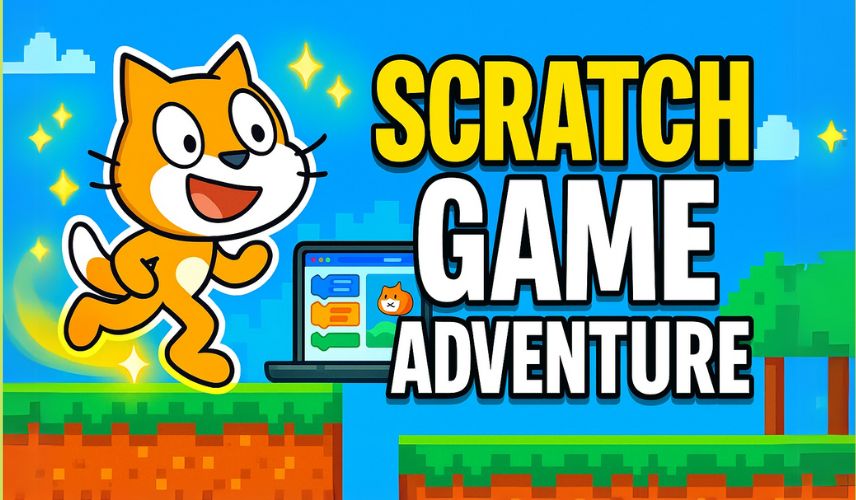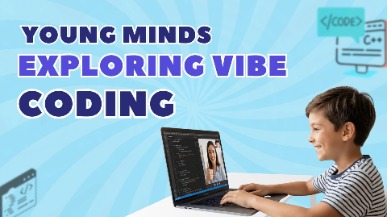How to Copy Code from Another Game in Scratch: A Step-by-Step Guide
- 3 February 2025
- Published by tutree
- STEM.org Accredited™ Partner

Ever wonder how game developers make amazing games fast? They learn from others' code. Copying code from another game in Scratch is a smart way to learn and grow.
Copying code lets you see how pros do it. It's great for both students and experts. You can learn new ways to code and understand games better.
Scratch, made by MIT, is a place where people share and learn. By copying code, you get better at programming. It's not just for making games.
Key Takeaways
- Understand the ethical guidelines for code reuse
- Learn advanced code copying techniques in Scratch
- Develop programming skills through strategic code analysis
- Explore creative ways to adapt and customize existing code
- Enhance your game development knowledge through practical experience
Want to get better at Scratch game development? Tutree offers free lessons. Call (408) 598-9105 to start your coding adventure!
Understanding the Basics of Scratch Code Sharing
Scratch is a cool place to learn how to copy code. It's a visual programming platform. Here, creators can share and learn from each other's projects.
Knowing how to share Scratch code is key. It helps you see how games are made. You'll learn to make your own games better.
Key Components of Scratch Projects
When you start copying code, you'll find important parts:
- Sprites: These are the game characters or objects.
- Scripts: These are the code blocks that make sprites do things.
- Backdrops: These are the backgrounds of your game.
- Event triggers: These start actions in your game.
Common Code Elements in Games
Scratch games use special code elements:
| Code Element | Purpose | Example Usage |
|---|---|---|
| Motion Blocks | Control sprite movement | Moving characters, simulating physics |
| Sensing Blocks | Detect interactions | Collision detection, user input |
| Control Blocks | Manage program flow | Conditional statements, loops |
Project Structure Overview
Knowing how projects are set up is key. Each Scratch project has parts that work together. Look closely at how scripts talk to each other.
"In Scratch, understanding the relationships between code blocks is more important than memorizing individual commands." - Scratch Community Insight
Essential Tools and Prerequisites for Code Copying
To copy code from another game in Scratch, you need to prepare. You must set up your digital space and get the right tools.
Before you start, make sure you have these things:
- Active Scratch account
- Updated web browser
- Stable internet connection
- Basic understanding of Scratch programming concepts
For copying code, you'll use the Scratch online editor. You also need to know how to read block-based programming. Setting up your space is important, but it's not just about tech.
| Tool | Purpose | Skill Level |
|---|---|---|
| Scratch Online Editor | Primary code exploration platform | Beginner to Intermediate |
| Web Browser | Access Scratch platform | Basic |
| Screen Capture Software | Document and analyze code | Intermediate |
Pro tip: Get to know Scratch's interface and code blocks before you try hard code copying.
"Understanding the tools is the first step to mastering code reproduction in Scratch" - Scratch Community Wisdom
Learning to spot and understand code structures helps a lot. It makes copying and changing game code easier.
Accessing the Scratch Project You Want to Copy From
Learning to copy code from another game in Scratch is fun. You need to find and navigate projects well. Scratch has many ways to find and explore game projects.
When looking for projects, use smart strategies. This helps you learn more. The Scratch community is full of chances to explore and get inspired.
Finding Relevant Projects
To find good projects, follow these steps:
- Use the Scratch search bar with specific game genre keywords
- Browse featured projects in the Scratch community
- Check project recommendations based on your interests
- Explore curated collections by experienced Scratch developers
Viewing Project Source Code
It's important to know how to see source code in Scratch. Each project shows different coding ways:
- Click the "See Inside" button on any project
- Navigate through different sprite scripts
- Examine individual code blocks carefully
- Study script interactions and logic flows
Understanding Project Permissions
Copying code ethically means respecting creator rights and rules. Keep these points in mind:
| Permission Type | What It Means | Action Required |
|---|---|---|
| Remix Allowed | Project can be modified | Credit original creator |
| Read-Only | Cannot modify directly | Study code, create inspired version |
| No Derivatives | Cannot copy or modify | Seek alternative projects |
Always be respectful and follow rules when exploring Scratch. Make sure you know and follow each project's guidelines.
How to Copy Code from Another Game in Scratch
Copying code from another game in Scratch can really help you learn. It's important to pay close attention and plan well when you do it.
To copy code from another game in Scratch, follow these steps:
- Open the original project in the Scratch editor
- Find the code blocks you want to copy
- Click and select the code you need
- Right-click to copy
- Go to your project
- Paste the code into the right place
When copying code, remember a few important things:
- Script compatibility between projects
- Matching variable names and structures
- Changing the code to fit your game
Pro tip: Always check and test the copied code in your project.
Learning to copy code well can really boost your Scratch skills. Not all code will work right away, so you might need to change it.
| Code Copying Step | Key Considerations |
|---|---|
| Code Selection | Find the right, working code segments |
| Code Transfer | Put it in the right place in your project |
| Code Adaptation | Change it as needed for your project |
By following these tips, you can learn to copy code from other games in Scratch. This will help you get better at programming.
Navigating the Scratch Editor Interface
Learning to copy code from another game in Scratch starts with the editor interface. It might look hard at first. But with practice, you'll get good at using it.
Understanding the Code Blocks Panel
The code blocks panel is your main tool for copying code. It has blocks for different things:
- Motion blocks for moving sprites
- Looks blocks for visual changes
- Sound blocks for audio interactions
- Control blocks for programming logic
Working with Sprites and Scripts
Sprites are the characters or objects in your project. Each sprite can have many scripts. When copying code, watch these things:
- Sprite selection
- Script arrangement
- Block connections
Managing Multiple Scripts
Copying code well means managing scripts well. Pro tip: Keep your scripts organized and connected right. This keeps your game working when you move code.
"Clean, organized code makes copying and adapting much easier." - Scratch Community Wisdom
Getting good at the Scratch editor takes time. Take your time to learn each part. See how different blocks work together.
Identifying the Specific Code Sections to Copy
Learning to copy code from another game in Scratch is key. You need to find the right code parts for your project. This means looking closely and choosing wisely.
First, check the game's main parts. Find scripts that make the game special or fun. Your job is to pick code bits that fit your project.
- Analyze sprite movement scripts
- Examine collision detection logic
- Review scoring and game progression mechanisms
- Identify event handling code
To copy code well, follow these steps:
- Open the project in Scratch editor
- Click on different sprites to view their scripts
- Identify reusable code blocks
- Understand the script's purpose and structure
| Code Section | Key Characteristics | Copyability |
|---|---|---|
| Movement Scripts | Controls sprite navigation | High |
| Collision Detection | Manages interaction between objects | Medium |
| Game State Management | Handles game progression | Low |
Pro tip: Always make sure the code fits your project's needs and design.
"Smart code copying is about understanding, not just copying blindly." - Scratch Community Wisdom
Best Practices for Code Implementation
Learning to copy code from another game in Scratch needs planning and care. It's not just about copying and pasting. You must do it right.
Organizing Your Code Blocks
Keeping your code organized is key. Here's how to make your project easy to handle:
- Group related scripts together
- Use clear and descriptive variable names
- Create color-coded code block sections
- Add comments to explain complex code segments
Testing and Debugging Techniques
Testing your code is very important after copying. Here's how to check it:
- Run the script in small segments
- Check for unexpected behaviors
- Compare original and copied functionality
- Isolate and resolve potential conflicts
Optimizing Performance
Make your Scratch code run well. Here are tips to help:
- Minimize redundant script operations
- Reduce complex computational processes
- Streamline sprite interactions
- Use efficient broadcasting mechanisms
"Clean code is not just about making it work, but making it work efficiently and readably." - Scratch Community Wisdom
Remember, making your code work well takes time and effort. Keep improving your Scratch project.
Common Challenges and Troubleshooting Tips
When you try to copy code from another game in Scratch, you might hit some bumps. Knowing these problems can make copying code easier.
- Block Compatibility Issues
- Script Interaction Problems
- Performance Limitations
- Variable Mapping Errors
Scratch developers often face big challenges with code. Spotting problems early can save a lot of time.
"Code copying needs careful analysis and smart planning" - Scratch Community Insights
Here are some tips for fixing common problems when copying code in Scratch:
- Make sure script connections between sprites are right
- Check if variable scopes and definitions match
- Test code bits one by one
- Compare original and copied scripts very carefully
| Challenge | Potential Solution |
|---|---|
| Unexpected Script Behavior | Check and match code block sequences |
| Performance Slowdowns | Make script complexity simpler |
| Missing Event Triggers | Make sure event handling is correct |
Remember, copying code well takes patience and careful problem-solving. Always test your code well to make sure it works right.
Customizing Copied Code for Your Project
Learning to copy code from another game in Scratch is just the start. It's key to make it your own for a unique game. You need to tweak and think creatively to get it right.
Adapting code well means using smart strategies. These help turn someone else's code into your own game pieces.
Modifying Variables and Values
To make copied code your own, focus on changing important variables:
- Change numbers to fit your game's rules
- Give variables new names for your game
- Make the math parts match your game's style
Adapting Scripts to Your Game
Changing scripts needs a smart plan. Here are key steps:
- Look at what the script does mainly
- Find parts you can change for your game
- Try small changes first
| Adaptation Strategy | Key Considerations |
|---|---|
| Variable Replacement | Match game-specific requirements |
| Script Restructuring | Maintain original logic while personalizing |
| Performance Optimization | Streamline code for smoother gameplay |
Pro tip: Always save your original copied script as a backup before making extensive modifications.
"Creativity in code adaptation separates good game designers from great ones." - Scratch Community Wisdom
Testing and Debugging Your Implemented Code
Learning to copy code from another game in Scratch is exciting. But, testing is key to making sure it works right. Debugging helps find and fix problems that might pop up.
First, run your Scratch project and watch how it acts. Look for any weird actions or errors. These can mess up your game.
Focus on:
- Script execution
- Sprite interactions
- Event triggers
- Variable calculations
When you debug code from another game in Scratch, try these tips:
- Run the project in test mode many times
- Check each script block for any problems
- Make sure variables are set right and calculations work
- Compare your code with the original project
"Good debugging is like detective work – systematic and patient."
Scratch has tools to help you debug. Use Show Watchers to see how variables change and scripts run. This helps you find where things go wrong.
Remember, making code work well takes time and patience. Don't worry if it takes a few tries to get it right.
Legal and Ethical Considerations in Code Copying
When you learn to copy code from another game in Scratch, knowing the law and ethics is key. The Scratch community loves creativity, working together, and respecting original work.
Copying code is more than just knowing how to do it. It's about knowing who owns the ideas. Before you use code from someone else, you must be careful.
Understanding Creative Commons Licensing
Creative Commons licenses help share and use digital stuff legally. In Scratch, these licenses tell us how to use and share code:
- Attribution-only licenses
- Non-commercial sharing permits
- Modification restrictions
Proper Attribution Methods
When you copy code, giving credit shows you respect the creator. Here's how to do it right:
- Credit the original project creator
- Link to the original Scratch project
- Tell which code parts you used
| License Type | Usage Permissions | Attribution Requirements |
|---|---|---|
| CC BY | Full use with modification | Creator name and project link |
| CC BY-NC | Non-commercial use only | Creator name, project link, non-commercial disclaimer |
| CC BY-SA | Share-alike modifications | Creator name, identical licensing for derivative work |
Remember: Ethical code copying isn't just about technical skill—it's about respecting the creative community and maintaining collaborative integrity.
Advanced Code Integration Techniques
Learning to copy code from another game in Scratch is tricky. It needs smart ways to mix new and old code. This makes your project better.
Here are some important steps to follow:
- Code Modularization
- Script Layering
- Variable Remapping
- Performance Optimization
Breaking down big scripts into small parts is key. It helps you use code from other games better.
"The art of code integration is not about copying, but understanding and adapting." - Scratch Community Wisdom
Here are some advanced ways to mix code:
- Look at how the original project is set up
- Find parts of the code that you can use
- Change variables to fit your project
- Test each part by itself
| Integration Technique | Difficulty Level | Recommended Skill |
|---|---|---|
| Script Decomposition | Intermediate | Logical Thinking |
| Variable Mapping | Advanced | Algorithmic Understanding |
| Performance Tuning | Expert | Optimization Skills |
Getting good at code integration takes time and effort. Every script you copy is a chance to get better at Scratch.
Tips for Optimizing Copied Code Performance
Learning to copy code from another game in Scratch is exciting. But, making your game run smoothly is key. Good code makes your game fast and fun.
First, look at the code's structure. Find parts that slow it down. Making your scripts simple helps your game run better.
- Remove code that's not needed
- Make complex scripts simpler
- Do less repeated work
- Manage variables well
Knowing how to make code efficient is important. Here are some tips:
| Optimization Technique | Performance Impact |
|---|---|
| Reduce nested conditionals | Decreases processing time |
| Limit broadcast messages | Improves script communication |
| Use local variables | Minimizes memory usage |
Pro tip: Always test your optimized code thoroughly to ensure functionality remains intact while improving performance.
"Efficient code is the backbone of a great Scratch game" - Scratch Community Wisdom
Optimization is a never-ending job. Keep checking and improving your scripts. This way, you'll make your game the best it can be.
Conclusion
Learning to copy code from other games in Scratch is fun. It helps young programmers grow. You can make more complex games by following this guide.
Copying code means learning from others and understanding game design. You'll find new ways to make games better. This helps you get creative with coding.
It's important to copy code the right way. Always give credit and follow creative commons rules. Tutree offers free lessons to help you learn more about Scratch game development.
Want to improve your Scratch game skills? Call Tutree at (408) 598-9105. Start your coding adventure today. With practice, you'll make your own amazing games.
FAQ
Is it legal to copy code from another Scratch project?
It depends on the project's Creative Commons license. Always check the original project's attribution requirements. Make sure you're following the creator's guidelines for code usage.
How do I find projects to copy code from in Scratch?
Search for projects in the Scratch community using the website's search function. Look for projects similar to what you want to create. Explore their code scripts.
What are the best ways to modify copied code to fit my project?
First, understand the original code's logic. Then, adapt variables and modify block parameters. Test it step by step to make sure it works with your game.
Can I completely copy another Scratch game?
No, don't copy another creator's game entirely. Use copied code as inspiration and learning material. Create your own unique project.
What should I do if the copied code doesn't work in my project?
Troubleshoot by comparing structures and checking for variable mismatches. Make sure sprite names are the same. Use Scratch's debugging tools to find and fix issues.
How do I properly attribute code I've copied from another project?
Add a comment in your project notes crediting the original creator. Include a link to their original project. Follow any specific attribution requirements mentioned in the project's description.
Are there any limitations to copying code in Scratch?
Yes, there are limitations. Complex custom blocks, project-specific extensions, and nuanced game mechanics may not work between different games.
What's the best way to learn from copied code?
Break down the code block by block. Understand each script's purpose. Experiment with modifications. Use the copied code to improve your Scratch programming skills.


